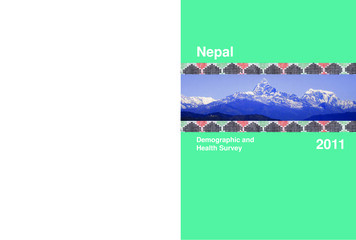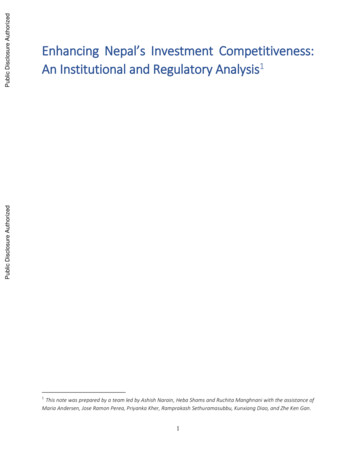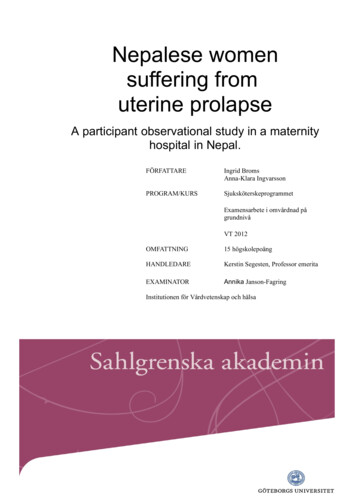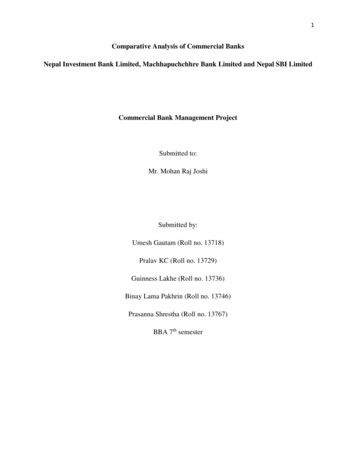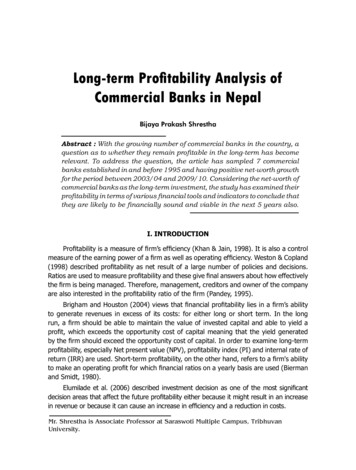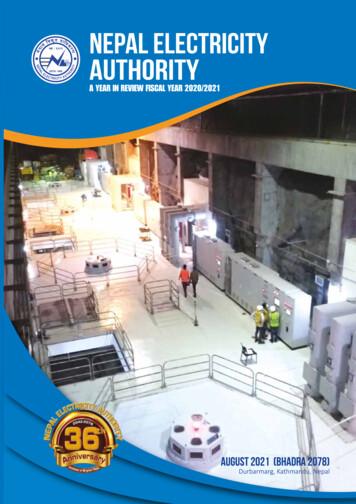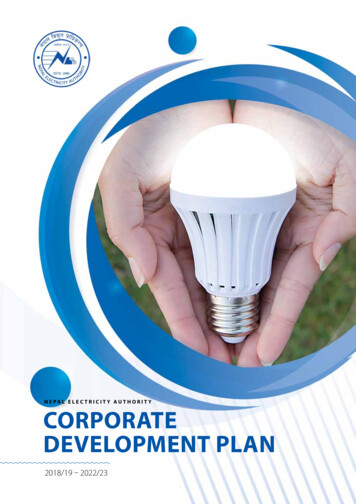
Transcription
N E PA L E L E C T R I C I T Y AU T H O R I T YCORPORATEDEVELOPMENT PLAN2018/19 – 2022/23
N E PA L E L E C T R I C I T Y AU T H O R I T YCORPORATEDEVELOPMENT PLAN2018/19 – 2022/23
COPYRIGHT
CORPORATE DEVELOPMENT PLAN 2018/19 - 2022/23Nepal Electricity Authorityserves 4 million customers, whocount on us every day to providesafe, reliable and affordable energy.Just as important, the country looksto us to provide smart, sustainablelong-term energy solutions topower Nepal’s economic and socialdevelopment. NEA has enduredsignificant challenges in the pastbut our accomplishments in the lastcouple of years clearly demonstratesthat we are committed and capableto meet these crucial challenges.MESSAGE FROMMANAGING DIRECTORWe have earned back the trust and confidenceof our customers by eliminating load sheddingacross the country. We are aware that thedebilitating load shedding caused numeroushardships to our customers not to speak ofthe significant economic and social loss to thecountry. At NEA we value our customers’ trust andtake our responsibility to meet their expectationsseriously and are resolutely resolved to never toreturn to the dark days of the last decade.The physics of electricity means that it isgenerated and consumed instantaneouslybut the process of delivering that electricityis anything but instantaneous. It is a result ofmeticulous planning that spans multiple years.The lack of an integrated long-term planningprocess at NEA is one of the important lessonswe have learned from the crisis. This is why, myteam and I have developed a 5-year CorporateDevelopment Plan (CDP) to achieve our Visionof becoming “an efficient modern utility thatprovides reliable, quality and affordable electricityto its customers while being responsive toGovernment imperatives and creating value forits shareholders.”The CDP will provide the roadmap for NEAto deliver on its mission of developing theinfrastructure for providing safe, reliable andaffordable electricity to all and serve as theengine that powers economic and socialdevelopment in Nepal. The CDP highlights ourpriority areas over the next five years which arestructured around three strategic themes:Theme 1: National PrioritiesTheme 2: Capable, Modern and Smart UtilityTheme 3: Improve Customer CareWith all the planned measures and activitiesexecuted, we will achieve the following goals:n A power system with an installed capacityof 5,000 MW and the transmission anddistribution infrastructure to support thiscapacityn Achieve per capita electricity consumption of500 kWhn Provide universal access to electricity throughon-grid and off-grid solutionsn Connect 400,000 customers annually and havea customer base of over six million consumersi
iiNEPAL ELECTRICITY AUTHORITYnnnnnnImprove Nepal’s Energy Security by generating100% of the electricity domesticallyReduce aggregate technical and commercial(AT&C) losses to less than 15%Modernize the grid to have 75% of the energysold billed through Smart and/or automatedmeters2 million customers use automated or onlinepayment optionsAt least double employee efficiency (sales/employee)Increase non-tariff revenue by monetizingsurplus energy through trade and byleveraging NEA’s assets and infrastructure togenerate new sources of revenueIn addition to the three Strategic Themes, theCDP outlines the steps NEA will undertake inresponse to the changing political, regulatory andpolicy framework that governs the sector. Nepalis at a historical juncture, and so is its electricitymarket. The electricity sector has evolved fromone in which NEA was solely responsible fortransmission, generation and distribution to onewhere there are multiple actors in each of theseverticals. Looking forward, NEA recognizes thatbig systemic changes are imminent even as thetiming and extent of reform is uncertain. Butwe also understand that the constant throughthese changes will be the fact that NEA is morethan just an electricity utility and will continue toplay a pivotal role in the evolution of the energysector in Nepal. NEA shoulders the responsibilityof being a key agency through which theGovernment aims to achieve its policy goals forthe energy sector including the development ofa vibrant and dynamic energy sector in Nepal.NEA takes these responsibilities with thegravity it merits. The CDP takes this intoaccount and outlines a strategy that envisionsa re-organization of its corporate structure tomeet the new challenges and opportunitiesthat will result from these changes. While theneed for re-organizing its corporate structureis driven by political imperatives of the newform of government, there are also businessbased reasons to embark on this path towardsa more efficient and responsive NEA. Thecorporate re-organization will be undertakento extract benefits of operational efficiencyand competition while avoiding the pitfallsof increased administrative costs, reducedeconomies of scale, inadequate technical andadministrative capacity and market disruption.That is why we will proceed with cautionand through a consultative process with allstakeholders.The CDP outlines and ambitious plan totransform NEA from an “old-school” utility toa modern, smart and capable utility. We haveenvisioned a quantum leap in the next five yearsthat will see our system grow by more than fourtimes the current size and more than double theper capita electricity consumption. We have a lotto work on, but we also have a lot to work with.If anything gives me faith that we will achievethese goals then it is the passion, commitmentand dedication of our employees. Just as wewill be making investment in our infrastructureto modernize our system, we will be investingin the development of our staff to meet thesenew challenges. I have a strong commitmentto ensuring the welfare of my most valuableresource, our management and staff, and we willdo so by re-tooling and upgrading their skills tomeet the challenges we have ahead.With the support and policy interventions of ourGovernment and people, I am confident thatNEA will be able to not only achieve, but evensurpass the targets and play an important role inthe economic and social development our greatcountry.KUL MAN GHISINGManaging DirectorNEA
CORPORATE DEVELOPMENT PLAN 2018/19 - 2022/23iiiACRONYMSAEPCAlternate Energy Promotion CenterKPIKey Performance IndicatorsAIIBAsian Infrastructure Investment BankMDBMultilateral Development BanksAT&CAggregate Technical & Commercial LossesMISManagement Information SystemBTBuild TransferMCCMillennium Challenge CorporationCDPCorporate Development PlanMoENMinistry of EnergyDAMDay Ahead MarketMoEWRIMinistry of Energy, Water Resources and IrrigationDFIDDepartment of International DevelopmentMoFMinistry of FinanceDoEDDepartment of Electricity DevelopmentNEANepal Electricity AuthorityDSMDemand Side ManagementNFRSNepal Financial Reporting StandardsERCEnergy Regulatory CommissionNORADNorwegian Agency for Development CooperationETFCElectricity Tariff Fixation CommissionNPTCNepal Power Trading CompanyFVAPFinancial Viability Action PlanO&MOperations and MaintenanceGDPGross Domestic ProductPPAPower Purchase AgreementGTDGeneration, Transmission, DistributionPRoRPeaking Run of RiverGoNGovernment of NepalRoRRun of RiverEIBEuropean Investment BankRoWRight of WayFDIForeign Direct InvestmentRPGCLRastriya Prasaran Grid Company LimitedGISGeographic Information SystemSPVSpecial Purpose VehicleHIDCLHydropower InvestmentDevelopment Company LimitedTAMTerm Ahead MarketTODTime of DayICTInformation Communication SystemT&DTransmission & DistributionIDCInterest During ConstructionUSAIDINPSIntegrated Nepal Power SystemUnited States Agency for InternationalDevelopmentIPPIndependent Power ProducersUSDUnited States DollarIRGInternal Revenue GenerationVUCLVidyut Utpadan Company LimitedJICAJapanese International Cooperation AgencyWECSWater and Energy Commission Secretariat
CONTENTSMESSAGE FROM MANAGING DIRECTORi1. MANDATE, MISSION, VISION,CORE VALUES AND POLICY OBJECTIVES12. CURRENT STATUS OF THE POWER SECTOR53. SITUATIONAL ANALYSIS134. STRATEGIC THEMES AND GOALS215. FINANCING THE DEVELOPMENT STRATEGIC PLAN476. RESTRUCTURING537. STRATEGIC PLAN IMPLEMENTATIONAND MONITORING FRAMEWORK618. ACTIVITY MATRIX65
TABLESTable 1:Table 2:Table 3:Table 4:Table 5:Table 6:Table 7:Table 8:Table 9:Table 10:Table 11:Table 12:Table 13:Table 14:Table 15:Table 16:Table 17:Table 18:Table 19:Table 20:The key legislative framework that governs the sectorWhite Paper, Ministry of Energy Water Resources and IrrigationLoad ForecastEnergy Balance TableNEA SCOT AnalysisNational PrioritiesGeneration MixTransform NEA into a Capable, Modern and Smart UtilityImprove Customer CareFunding FrameworkResource requirementTotal Financial Resources RequiredResource mobilization Plan - IRG RequirementIRG Funding Coverage RatiosResource Requirement from Debt ProvidersResource Requirement from GoNProjected Income Statement for the CDP periodNEA’s total forecast revenuesIRG Cover and Consumer Tariff ScenariosKey Performance Indicators for Monitoring and IGURESFigure 1:Figure 2:Figure 3:Figure 4:Figure 5:Figure 6:Core ValuesStakeholder FrameworkRisksImpacts & LikelihoodCurrent Electricity Market OverviewNepal Electricity Market Overview afterRe-structuring in the Plan PeriodFigure 7: Market Design After Re-structuring during the Plan PeriodFigure 8: Possible Nepal Electricity Market Overview AfterFurther Re-structuring beyond the Plan PeriodFigure 9: Market Design After Further Re-structuringbeyond the Plan PeriodFigure 10: Restructuring Milestone Timelines281919545556585858
viNEPAL ELECTRICITY AUTHORITY1.MANDATE, MISSION,VISION, CORE VALUESAND POLICY OBJECTIVES
CORPORATE DEVELOPMENT PLAN 2018/19 - 2022/231.1 NEA’S MANDATENepal Electricity Authority (NEA) came into existenceon August 16, 1985 following the consolidationof the Department of Electricity (Ministry of WaterResources), Nepal Electricity Corporation and severalBoards in the power sector. NEA derives its mandatefrom the Nepal Electricity Authority Act 1984 (TheAct) and takes policy direction from the Governmentof Nepal (GoN).The primary objective of NEA is to generate,transmit, and distribute adequate, reliable, quality,and affordable power by planning, constructing,operating, and maintaining power infrastructurefacilities. Its roles and responsibilities range fromrecommending policies, serving as a center ofexcellence and developing skilled human resourceson matters relating to the power sector. The Act alsogrants NEA the power to purchase electricity fromIndependent Power Producers (IPPs) and engagein cross border trade while introducing commercialorientation in its services. To fulfill its mandate, NEAcan tap both domestic and foreign capital from bothgovernment and commercial entities.1changing socio-political, environmental and marketconditions. In this context, NEA’s success is measurednot just by its individual achievements but also by itsrole in establishing a vibrant energy market.NEA’s vision and mission represent the aspirationsof a “Prosperous Nepal and Happy Nepali.” Thisvision embodies NEA’s ambition to provide worldclass service to its customers and create value forits stakeholders - customers, government, privateoperators. Therefore, the following articulated visionand mission statement of NEA provides a frameworkand focus to achieve its institutional mandate.VISIONAn efficient modern utility that providesreliable, quality and affordable electricityto its customers while being responsive toGovernment imperatives and creating valuefor its shareholders.1.2 VISION AND MISSIONThe political, economic and social fabric of Nepalhas undergone a massive transformation in thelast four decades. Similarly, the electricity marketwithin and outside Nepal has also evolved since NEAcame into operation. To meet the aspirations of agrowing nation and to address the challenges of adynamic electricity market while remaining true toits mandate, NEA needs new tools to respond to aMISSIONDevelop infrastructure to provide electricityfor all by constructing, maintaining, tradingand operating a safe, optimally engineeredgeneration, transmission and distributionpower system and build a strong relationshipwith customers by balancing service quality,reliability and costs.
2NEPAL ELECTRICITY AUTHORITY1.3 CORE VALUESThe ideals by which the organizationwill strive to carry out its business andconduct itself are embodied in thefollowing core values:FIGURE 1: Core ValuesNATIONBUILDINGSAFETY FIRSTDedicated to powerNepal’s development.EXCELLENCEPassion, commitmentand dedicationto excel.Safety of our customersand employees is firstand foremost.CORE VALUESTEAMWORKRealizing vision and missionthrough collaboration.CUSTOMERCENTRICITYMeeting customerneeds with qualityand reliability.ETHICS& INTEGRITYBuilding trust andimproving goodgovernance
CORPORATE DEVELOPMENT PLAN 2018/19 - 2022/233
4NEPAL ELECTRICITY AUTHORITY2.CURRENT STATUSOF THE POWER SECTOR
CORPORATE DEVELOPMENT PLAN 2018/19 - 2022/2352.1 ENERGY SUPPLY ANDCONSUMPTION2.2 NEA AND THE POWERSECTOR IN NEPALNepal’s energy requirements are predominantly metby traditional sources of energy. Biomass, in the formof firewood, agricultural waste, and animal dung, isresponsible for almost 76% of the total energy supply.Fossil fuels are responsible for 16% of the energysupply in the nation and its consumption is growingat a faster rate relative to other energy sources.Electricity meets only 3% of Nepal’s total energyneeds1.Despite its vast hydropower potential and longhistory in electricity (the first hydropower plantwas established in Nepal more than 100 years ago),only 3% of the country’s energy needs are met byelectricity. Nepal’s electrification rate (grid and offgrid) of about 91% is comparable to that of othercountries in the region3. As of FY 2017/18 there areabout 4 million customers across 76 districts of Nepalthat NEA serves through the national grid. 93.83%of these are domestic consumers and account for43.5% of the total electricity demand of 5557.3 GWh.Industrial consumers account for 37.53% of thetotal electricity demand. NEA’s electricity demandforecast, driven by industrial growth, urbanizationand grid expansion is expected to increase per capitaelectricity usage from 170 units/capita in 2017 to500 units/capita by 2023. Meeting this demand willrequire an installed capacity of about 5000 MW.On the consumption side, 82% of the total energydemand is driven by the residential, commercial andagriculture sectors. Demand from the transport andindustry sector stood at 10% and 5% respectively. Thegrowth in energy demand from industry (4%) andtransport (3%) are projected to increase faster thangrowth in Nepal’s aggregate energy demand whichis expected to grow at 1.9% through 20352. Thesemacro factors in the energy demand and supplyscenario create strong tailwinds for Nepal to meetits energy requirements with electricity. Meetingour energy needs with electricity is not only moreefficient and cleaner but will also ensure a moresecure energy future.The total installed capacity of the national gridis 1,074 MW with NEA hydro, IPP hydro and NEAthermal accounting for 507.9 MW, 512.7 MW and 53.4MW respectively. A decade long political insurgencyand underinvestment in the generation sectorresulted in demand for electricity outstripping supplyWECS 2017 Electricity Demand Forecast 2015-40ADB 2015 Energy Outlook for Asia and the Pacific. Manila3Electrification rate in the region 2016: Bangladesh 76%, India 85%, Pakistan 99%, Sri Lanka 96%Source S12
6NEPAL ELECTRICITY AUTHORITYresulting in years of debilitating loadshedding. This situation has seen adramatic turnaround in the last twoyears. Load shedding has ended in largepart due to substantial reduction insystem losses, proper system and loadmanagement by NEA and completionof the high voltage cross borderDhalkebar - Muzzafarpur transmissionline enabling efficient import of powerfrom IndiaEven though the national grid has aninstalled capacity 1074 MWs, 86% oftotal capacity comprises of RORs andPRoRs projects, and only about onethird of the total installed capacity canbe generated from these stations inthe dry season. So, while load sheddinghas officially ended, the seasonalimbalances caused by the hydrodominated system means that thecountry still imports a third of its powerrequirements from India. On an average380 MW of this power is imported fromIndia through the Power Exchangeand other trading mechanisms. Nepalis expected to be net surplus inelectricity within the next two years,but the seasonal and diurnal systemimbalances means trading of powerwith our neighbors will continue to bean essential part of our power narrative.As the sole buyer of electricity inthe sector, and a monopoly overtransmission, system operation anddistribution functions means thatNEA occupies a central and dominantposition in the electricity sector.GENERATIONIn generation, even though IPPsare increasingly contributing to theenergy supply, NEA’s own generationincluding its subsidiary generatingcompanies are still an influential force.The establishment of GoN subsidiarycompanies Hydropower InvestmentDevelopment Company Limited(HIDCL) and Vidyut Utpadan CompanyLimited (VUCL) is expected to furtherincrease the government’s influence ingeneration.TRANSMISSIONNepal’s transmission system hasgrown into a network of more than3,538 km of transmission lines from66kV to 400kV level. The transmissionsystem expansion and upgradation hasprioritized two key areas:1. Development of a 200kV/400kVhigh voltage domestictransmission backbone alongthe east-west. The 285 km 400kVHetauda-Dhalkebar-Duhabi line isunder construction in the center andeast of the country. The MillenniumChallenge Corporation (MCC)supported transmission line projectwill extend the 400kV line to Butwaland all the way to the border withIndia. Similarly, the Butwal-Attariya(400 km) 400kV line is under detaildesign phase and expected to becommissioned by 2025. Furthermore,400kV transmission lines along themid-hill highways and multiple rivercorridors are under study.2. Develop high voltage crossborder interconnections.Dhalkebar-Muzzafarpur, Nepal’s firstever 400kV Nepal-India cross-bordertransmission link is currently chargedat 220kV voltage level and importsup to 240MW power from India. It isexpected to be charged at 400 kV byDecember 2019 enabling trading ofa higher quantum between Nepaland India. A second cross-borderinterconnection with India is beingdeveloped from New Butwal (Nepal)to Gorakhpur (India). There are threeother high voltage interconnectionsunder study. Furthermore, thedevelopers of export-oriented Arun3 and Upper Karnali plan to builddedicated 400kV lines to evacuatetheir power to India. Cross-borderinterconnection with China is alsogaining traction. The Galchi (Nepal)to Kerung (China) line is in studyphase and discussions are alreadyunderway on the financing modality.While NEA has beenthe sole institutionresponsible for theplanning, developmentand management of thetransmission system, theestablishment of theRastriya Prasaran GridCompany Limited (RPGCL)is expected to changethis situation. RPGCL isexpected to support andaugment NEA’s effortsin the development ofNepal’s transmissionsystem. Given the currentchallenges to transmissionline development,private sector is notexpected to engagein the developmentof transmission linesalthough alternativemodalities such as BuildTransfer (BT) are beingconsidered.
CORPORATE DEVELOPMENT PLAN 2018/19 - 2022/23DISTRIBUTIONNEA is the sole distributor of electricity.The power distribution functioninvolves planning, expanding,operating, maintaining, andrehabilitating the power distributionnetworks, including substations up tothe 33kV level, and providing consumerservices such as new connections,meter reading, billing, and revenuecollection. In the FY 2017/18 NEAserved 4 million consumers, sold 5,526GWh of energy earning gross revenueof Rs. 55,468 million. Industrial andcommercial consumers had only 1.98%share of total customers but provided44.91%% of the total revenue4.Ensuring universal access to electricityis a key government priority and NEAworks closely with GoN to achievingthis goal. To accelerate the pace ofgrid extension and manage ruraldistribution systems more efficientlyand sustainably NEA has adoptedcommunity participatory models inrural electrification schemes. This model45serves about 500,000 households. Andyet, given Nepal’s geography it is noteconomical to expand the grid to serveevery citizen through the grid. Off gridsolutions are the only viable alternativeto reach the remotest areas and theseare usually provided by the AlternateEnergy Promotion Center (AEPC) and insome cases by NEA as well.ELECTRICITY TRADERegional trade in electricity has beena long-cherished aspiration for thecountries of South Asia. Progress hadbeen slow but recent developmentshave been encouraging. The recentlyissued cross-border guidelines by theMinistry of Power in India creates theenabling framework and bodes wellfor the future of cross-border trading.There are however existing tradingarrangements between Nepal andIndia. Electricity imports are governedby the Power Exchange Committeebetween Nepal and India, and tradingarrangements between NEA and Indianpower trading companies.NEA a Year in Review – Fiscal Year 2017/2018ADB 2015 Energy Outlook for Asia and the Pacific. Manila7The energy banking mechanism allowsNepal to export power to India amidsurplus generation and import thesame amount of power during dryseason. Furthermore, India has openedits power exchange market to itsneighboring countries. Nepal can nowtrade power through Power Exchangemarkets for the day-ahead market(DAM) and term-ahead market (TAM).In addition to enabling trade withIndia, the recently issued Cross-BorderPower Trade guidelines by the Ministryof Power, India will enable trade withthird countries such as Bangladesh andBhutan by utilizing India’s transmissionnetwork.OTHER RENEWABLES ANDALTERNATIVE ENERGYNepal mostly relies on renewables forits off-grid electricity supply. Otherthan major hydropower operations,around 23MW of electricity generationcame from micro hydro schemes,12 MW from solar photovoltaic (PV)systems, and less than 20kW from
NEPAL ELECTRICITY AUTHORITYSolar power provides an attractiveoption to diversify Nepal’s generationmix. Fall in price of photovoltaic solarpanels in the international market andgood power purchase rate offered bythe NEA (Rs. 7.30 per unit) has beentwo key factors to attract investmentsin solar. NEA is currently developingits own 25 MW solar plant in Devighatand signed agreements with IPPs for 20MW with Viability Gap Funding (VGF)support from ADB. Furthermore, NEAhas also signed PPA for a total of 40 MWgrid solar.2.3 KEY PLAYERS INTHE ENERGY SECTORThe Ministry of Energy, Water Resourcesand Irrigation is the key line Ministrythat has oversight of the electricitysector in Nepal. There are severalgovernment institutions (independentand under the ministry) that derivetheir mandate and responsibilities fromtheir specific Acts or sub-legislations.The Electricity Act 1992 and theElectricity Regulation 1993 are the mainlaws governing the electricity sector inNepal. The Electricity Act 1992 covers allissues regarding survey, generation anddistribution of electricity along with thelicensing terms and regulations. TheElectricity Regulation 1993 supportsthe Act and sets out procedures forobtaining licenses for generation,transmission and distribution projects.TABLE 1: The key legislative framework that governs the sector are as follows:THE ELECTRICITYACT OF 1992THE NEA ACT 1984THE HYDROPOWERDEVELOPMENTPOLICY 2001THE ELECTRICITYREGULATORYCOMMISSION (ERC)ACT 2017The Act aimsto regulate thesurvey, generation,transmission anddistribution of theelectricity to fosterdevelopment andmanagement ofthe electricity whileensuring safetyand standardizingelectricity services.Enacted to establishthe verticallyintegrated stateutility, the NepalElectricity Authoritythat would supplypower by generating,transmitting anddistributing electricity.Outlines thepolicies to engageand attract theprivate sector inthe developmentof hydropowerand provide theenabling legislativeand regulatoryframework.The ERC Act pavesthe way for theestablishment ofan independentregulator for theelectricity sector.Due to the process of federalism and the dynamics of multi-layered governance,amendment to the Electricity Act 1992 is required. Clarity in project development,energy infrastructure governance and operation of inter-municipal and provincialmarkets will be required. Similarly, the Act does not sufficiently consider the dynamicsof today’s energy sector such as trade of electricity within and across the border.The current power sector stakeholder framework is shown by the figure below:FIGURE 2: Stakeholder FrameworkENERGY SECTOR INSTITUTIONAL SETUPLEGAL AND REGULATORYAUTHORITIESwind energy5. GoN issued a subsidyscheme for renewable energy in2013 that has helped to better thedelivery of renewable energy services,technologies and supply to households,communities and businesses in ruralareas.LICENSE AND MARKETENTITIES8MoEWRI,GONPolicy and legislatorERCRegulationAEPCAlternative EnergyNEAGenerationTransmissionDistributionSystem OperatorRural ElectrificationDoEDLicensing &ImplementationWECSPolicy & AdvisoryIPPsGenerationState-owned enterprises (SOEs)Generation: VUCL, HIDCL, NEA SubsidiariesTransmission: RGPCLBulk ConsumersElectricity Cooperatives
CORPORATE DEVELOPMENT PLAN 2018/19 - 2022/23MINISTRY OF ENERGY,WATER RESOURCES ANDIRRIGATION (MOEWRI):DEPARTMENTOF ELECTRICITYDEVELOPMENT (DOED):The ministry is responsible forformulating policies, regulations andstandards for the sustainable long-termdevelopment, protection, usage andallocation of water resources andenergy.DoED is responsible for assistingMoEWRI in implementation ofoverall government policies relatedto electricity sector. DoED is GoN’slicensing agency for all energy relatedservices. It has the mandate to awardSurvey, Generation, Transmissionand Distribution license. Licenses aregenerally issued on a first come firstbasis although some project licenseshave been issued on a competitivebasis.ELECTRICITY REGULATORYCOMMISSION (ERC):The ERC Act 2017, paved the wayfor the establishment of a regulatorfor the electricity sector. However,the Commission has not beenoperationalized due to a delay in theappointment of the Commissioners.The ERC has the mandate to developand foster a transparent, competitiveand financially viable electricity sectorby:1. Setting technical and performancestandards such as Grid Code,Distribution Code, Operation &Maintenance Guidelines Determinewhole and retail tariff for generationand distribution respectively,approve PPAs and wheeling chargesfor transmission2. Protect consumer interest byensuring affordable, quality and safepower to consumers3. Resolve disputes and4. Provide policy recommendations tothe governmentWATER AND ENERGYCOMMISSIONSECRETARIAT (WECS):The primary responsibility of WECSis to study and plan the water andenergy resources of the country in anintegrated and accelerated manner. Ithas the mandate to formulate policiesand plan water resources relatedprojects.ALTERNATIVE ENERGYPROMOTION CENTER(AEPC):AEPC’s main objective is to developand promote renewable and alternativetechnologies in Nepal. It aims tomainstream renewable energy throughincreased access and knowledge ofcleaner sources of energy to improvethe living standards of people in Nepal.Its strategic objectives are the following:9STATE OWNEDENTERPRISES (SOES):Rastriya Prasaran Grid Co Ltd(RPGCL) was established by theGovernment of Nepal in July 2015 totransmit and evacuate power for thedevelopment and operation of thehydropower sector.Hydroelectricity Investment andDevelopment Company Ltd. (HIDCL)was formally established in July 2011to mobilize funds from domesticand international resource-base tofinance projects in middle to megasized generation, transmission anddistribution projects.Vidhyut Utpadan Company Limited(VUCL) was formally establishedin November 2016 to supportthe government in developingeconomically viable electricity projectsand enhance the country’s energysecurity.INDEPENDENT POWERPRODUCERS (IPPS):1. To popularize and promote the useof alternative/renewable energytechnology.2. To raise the living standard of therural people.3. To protect the environment.4. To develop the commercially viablealternative energy industries in thecountry.IPPs have been increasing theirinvestment on the generation side. IPPscurrently supply more than 30% of thepower in Nepal. NEA has already signedPPAs with IPPs for more than 5500 MW.These are mostly ROR projects with afew exceptions.NEPAL ELECTRICITYAUTHORITY (NEA):Multiple donors and developmentpartners are involved in the powersector. Development partners such asthe World Bank, Asian DevelopmentBank, DFID, USAID, MCC, GIZ, KFW, JICA,NORAD, EU, EIB, AIIB and others supportgeneration, transmission, distribution,rural electrification, clean cooking andenergy efficiency in varying capacities.NEA is the main electricity utility ofNepal. It is the sole purchaser anddistributer of grid electricity in thecountry and also operates a majority ofthe transmission network. Though thereare multiple generators in the country,NEA is still the largest generator and willcontinue to occupy an important rolein electricity generation.DONORS ANDDEVELOPMENT PARTNERS:
10NEPAL ELECTRICITY AUTHORITY2.4 POLICYOBJECTIVESNEA was established by the Act, as awholly government undertaking, andupholds its original charter mandatewhile fulfilling government policies andguidelines articulated and prioritizedover various time horizons.scope and timing of these changes hasto be ascertained, but the Constitutionprovides a framework and
Nepal Electricity Authority (NEA) came into existence on August 16, 1985 following the consolidation of the Department of Electricity (Ministry of Water Resources), Nepal Electricity Corporation and several Boards in the power sector. NEA derives its mandate from the Nepal Electricity Authority Act 1984 (The
